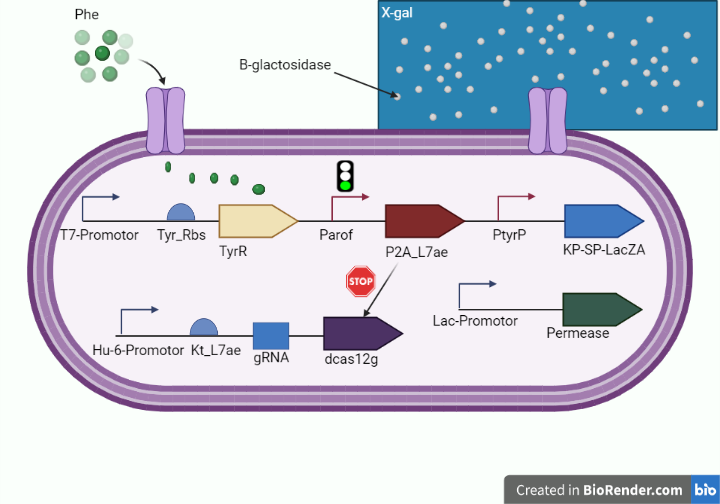Difference between revisions of "Part:BBa K4140007"
(→Part Description) |
Ahmed Mattar (Talk | contribs) (→Usage) |
||
| Line 8: | Line 8: | ||
==Usage== | ==Usage== | ||
| − | To transmit the response of our circuit to high levels of phenylalanine from intracellular to extracellular we linked Kp Sp signal at the N-terminus of the PAH for transmitting it extracellularly to hydroxylate excess phenylalanine into tyrosine. | + | To transmit the response of our circuit to high levels of phenylalanine from intracellular to extracellular we linked Kp Sp signal at the N-terminus of the PAH for transmitting it extracellularly to hydroxylate excess phenylalanine into tyrosine in the therapeutic circuit and to export beta-galactosidase extracellularly to turn the color into blue once bound to its x-gal substrate. as shown in figure 1 and 2. |
| + | [[File:wcb.png| ]] | ||
| + | Figure 1. (shows the tagging of LacZ alpha with kp-sp in the diagnostic whole cell-based biosensor.) | ||
| + | |||
| + | [[File:therap.png| ]] | ||
| + | Figure 2. (shows the tagging of PAH with kp-sp in the therapeutic whole cell-based biosensor.) | ||
==Literature Characterization== | ==Literature Characterization== | ||
Revision as of 09:46, 7 October 2022
kp-sp
Part Description
KP-SP is a secreted signal peptide at the N-terminus of the reporter protein that enables it's secretion extracellularly with high efficiency which indicates the versatility of this signal peptide and its significant potential in heterologous protein expression. this peptide comes from E.Coli as well as actinomycetes and can be secreted under normal instances
Usage
To transmit the response of our circuit to high levels of phenylalanine from intracellular to extracellular we linked Kp Sp signal at the N-terminus of the PAH for transmitting it extracellularly to hydroxylate excess phenylalanine into tyrosine in the therapeutic circuit and to export beta-galactosidase extracellularly to turn the color into blue once bound to its x-gal substrate. as shown in figure 1 and 2.
 Figure 1. (shows the tagging of LacZ alpha with kp-sp in the diagnostic whole cell-based biosensor.)
Figure 1. (shows the tagging of LacZ alpha with kp-sp in the diagnostic whole cell-based biosensor.)
 Figure 2. (shows the tagging of PAH with kp-sp in the therapeutic whole cell-based biosensor.)
Figure 2. (shows the tagging of PAH with kp-sp in the therapeutic whole cell-based biosensor.)
Literature Characterization
References
Sequence and Features
- 10COMPATIBLE WITH RFC[10]
- 12COMPATIBLE WITH RFC[12]
- 21COMPATIBLE WITH RFC[21]
- 23COMPATIBLE WITH RFC[23]
- 25COMPATIBLE WITH RFC[25]
- 1000COMPATIBLE WITH RFC[1000]

